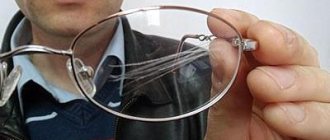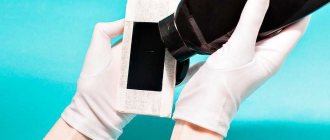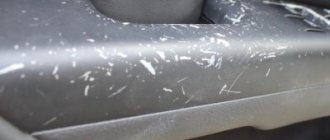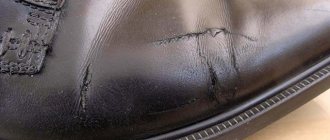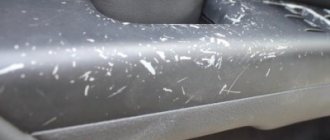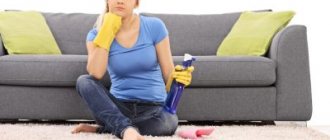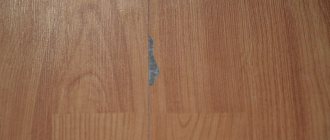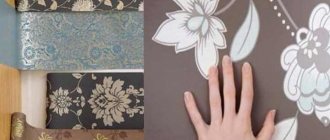Electronic technology has become firmly entrenched in our homes. It has become commonplace to have several televisions in an apartment.
Living with us, household electrical appliances undergo the consequences of cleaning, moving from place to place, and touching human hands. All this leads to the settling of a layer of dust on surfaces, monitor and TV screens, the appearance of fingerprints, darkening and stains.
Dust, due to its properties (especially when wet), is a conductor of electricity. The electromagnetic field attracts the smallest particles layer by layer to the panel and internal parts.
So how can you protect yourself from unnecessary consequences when wiping your TV screen at home?
Features of television screens
According to the type of displays, the following types are distinguished:
- CRT - cathode ray tube;
- LCD - liquid crystal;
- plasma;
- oled
Let's consider the features of each type in relation to proper cleaning and maintenance at home.
CRT - cathode ray tube
Model from the times of the USSR. The TV was called a “box”. Indeed, the loose wooden frame of an old non-working appliance could become a useful storage container.
Most of the device was occupied by a picture tube (CRT) - the prototype of modern screens and monitors. This is a solid glass flask with technical bells and whistles.
There was no question about the appearance of cracks and dents, since such flaws inevitably led to failure of the equipment.
Modern television receivers, instead of a picture tube, are equipped with a matrix with different technical designs. This is important to know, especially when planning a thorough wipe down with pressure on the screen. For example, to remove splashes, stains or traces of children's hands.
LCD - liquid crystal
A color monitor made of two panels, with a special liquid pumped between them. On the inside there is a light source that affects the characteristics of the liquid, changing the position of the crystals.
The applied filters, like in a mosaic, create areas with a certain contrast and illumination. This creates a visible, clear color image.
The difference between LCD and LED models is the light source. The first option uses fluorescent lamps, the other uses LEDs.
In general, this does not affect the screen wipe.
Plasma displays
The screen consists of cells filled with gas. The color of the element changes under the influence of electric current. These are large format models that accumulate a lot of dust.
OLED
The color panel is made of LED pixel elements that emit light.
These are expensive TVs and therefore proper care is important.
Types of pollution
Rags used to wipe dishes or cutlery are not suitable for cleaning the screen of a gadget; you should not spray the monitor with water or liquid for cleaning glass surfaces. How to wipe the display depends largely on the type of dirt.
Dust
Even if the floors are washed and cleaned daily, you still have to clean the monitor. Taking a piece of soft cloth or a dry sponge, you need to swipe the screen several times and this is enough to remove the settled dust.
Insect marks
Stains on the laptop are left by flies, midges that fly into the apartment through the window, and moths that live in cereals and flour. Traces are removed with a special napkin. To avoid scratching the screen, do not scrape off insect stains with a blade.
Mud tracks
It is not recommended to wash the monitor with water even when there are food residues, glue, or cosmetics on it, since the liquid flows into the compartments and openings. Old stains that cannot be removed with a napkin are cleaned with table vinegar and wiped dry with a rag.
Fat stains from fingers
To remove oil marks on a laptop or tablet monitor, a special liquid is sold in hardware stores. You cannot remove greasy stains with compounds that contain ethyl alcohol. It is better to wipe off the dirt with soap, but not with household soap, but with baby soap.
How to wipe TV screens at home and how to properly get rid of stains and dirt
Now, armed with knowledge about the technical features of displays, let’s look at how to properly care for various TV screens without compromising their integrity, and what types of TV care products exist.
Old CRT TVs
The glass picture tube is not afraid of modern cleaning agents. The basic rule is to prevent liquid or spray from getting inside.
Therefore, before cleaning, be sure to not just turn off the device, but unplug the power cord from the socket. And only after the case and kinescope have dried can you turn it on.
To wipe the screen, use a damp cloth soaked in soapy water. Modern soft fibers with alcohol compounds, glass cleaning fluid, etc.
With success, the screen can be lightly scraped to remove stuck objects, such as children's chewing gum.
This is an undoubted advantage of older models.
How to clean and clean LCD TVs from dust, stains
A popular and affordable type of electronic equipment. However, improper care can overshadow the owner of a modern gadget.
A special feature of the front panel is its sensitivity to aggressive media: acetone, solvent, gasoline, car cosmetics, etc.
Also, a cloth moistened with damp plain water will not only not remove dust, but will contribute to the occurrence of washouts and streaks.
So how to wipe LCD TVs and how to get rid of streaks on the screen?
For this purpose, lint-free fabrics that do not contain abrasive threads and solid weave are suitable. Special sets and napkins.
The best means of cleaning the screen are:
- lint-free soft fleece, flannel, flannel;
- microfiber cloths;
- cotton napkins.
These materials require a special cleaning agent. These can be sprays, gels and foams without an alcohol composition.
For example:
- Patron F3-029 foam;
- colorway 1032 spray with antistatic coating reduces the attractive properties of the panels.
Is it possible to wipe LCD TVs with wet wipes?
Yes, you can use special sets or separate disposable materials.
It is important that the packaging has a purpose - for caring for the screens of LCD monitors, televisions, and plasma panels.
How to wipe a TV screen and how to clean a monitor, how to wash a TV using quantum dots - video instructions:
Plasma panels
Due to the design features (the presence of LED cells), the models are endowed with significant dimensions. These are more powerful devices compared to LCDs, so the attractive properties of dust suspensions are increased.
In addition, fingerprints often remain when carried.
How to clean a plasma TV at home?
Manufacturers recommend using dry wipes and cloths for periodic screen care.
Microfiber cloths for wiping glass and mirror surfaces, according to experts, are the best solution. The material will allow you to remove dust and contaminated areas without the use of wet cleaning.
If you are unable to clean using this method, you can use a set of cleaning wipes. Contains dry and wet matter.
Plasma can also be cleaned with soapy water. To do this, fill a container with a spray bottle with warm and clean water and add 2-3 drops of liquid soap.
It is important that there is no excessive foam.
Rules for caring for a TV - how to wipe the TV and how to wash it properly:
How to wipe Qled TV
Reminder - the matrix consists of LED honeycombs. Strong pressure can cause mechanical destruction of the elements.
How to clean Oled TVs at home?
The requirements are identical to the conditions for caring for LCD TVs: soft lint-free fabrics, fibers, special wipes.
Cleaning products - any suitable for monitors and panels.
Professional products
There are special cleaning products that can effectively clean the LCD screen:
- wet cleaning wipes;
- cleaning fluid;
- microfiber;
- sets of dry and wet wipes for cleaning.
Wet cleaning wipes
The easiest way is to wipe the equipment with wet wipes without alcohol. They are lint-free, so they remove dust and dirt accumulations well. Impregnated with a cleaning solution that effectively cleans the display.
Application: treat the entire surface of the screen with a napkin, wait until dry. Then wipe with dry microfiber.
How and what not to wipe modern TVs
A simple and straightforward process can cause trouble for owners of television receivers if the following recommendations are not followed:
- Do not use fabrics and materials containing wood components : disposable paper napkins and towels, toilet paper and handkerchiefs, newspapers. The abrasive properties of such wipes can cause invisible scratches.
- Body wipes are not a screen cleaner.
- Apply the cleaner to the cloth, not to the panel . The level of moisture should not cause wet streaks.
- Wet wiping does not mean that the surfaces should have streams that can penetrate inside and get onto the electrical circuit.
- Do not apply strong pressure on the screen when wiping . Mechanical destruction of the crystal structure is possible. Visible dark spots in the form of streaks or streaks will appear.
What not to use
Having decided to start cleaning the monitor, it is worth finding out what means can render it unusable, which is strictly prohibited from being used for this purpose.
See also
How and what is the best way to clean coins made of different metals at home
Plain paper napkins
Towels that are used to wipe dishes after washing leave lint on a smooth surface, and it is almost impossible to remove them. Paper may cause scratches.
It is not recommended to rub stains on the monitor with wipes soaked in ethyl alcohol.
Rough cloth and towels
Rubbing with a hard material leads to cracks on the surface and, over time, damage to the screen. When cleaning a tablet or laptop with a towel, lint sticks.
Foam sponges
To prevent stains from appearing on the monitor, which will then take a long time to wash, you need to know that such surfaces cannot be wiped with foam rubber. The sponge sucks up dirt, crumbs, lint that scratches the screen and leaves marks.
Dish and glass cleaners
Liquids, gels, sprays that do an excellent job of removing grease on plates, removing coffee and tea stains, wiping dust on glass, are not suitable for cleaning monitors, but are intended for washing dishes and cutlery.
Sharp objects
Blades and knives remove traces of chewing gum and the presence of insects, but touching the screen damages the coating.
Scotch
It is not recommended to use adhesive tape used in everyday life to wipe dust on a laptop, since it sticks to the surface, and removing traces left by tape is not so easy.
Wet wipes for personal hygiene
Do not clean the monitor with a melanin sponge, embossed materials, or old cloth. Some items contain abrasive substances, while others shed lint. Sanitary napkins leave marks.
Alcohol
The displays of modern tablets and laptops are covered with a special film, which reduces the effect of the sun's rays and removes glare that degrades images. However, the structure of such material reacts negatively to ethyl alcohol, acetone or ammonia, which are present in glass cleaners and dishwashing gels.
How to remove grease stains and heavy dirt from LCD screens at home
If the use of special cleaning products does not lead to the desired result, you can use traditional methods:
- Isopropyl alcohol , a disinfectant liquid for cuts, is sold at any pharmacy. The medicine is diluted in a 1:1 ratio with water. Apply to fabric and wipe off dirt.
Afterwards the panel is wiped with a damp and then dry cloth.
- The vinegar solution will remove fingerprints and stains from household chemicals. You will need 3% table vinegar, prepare the composition in a 1:1 ratio with water.
- Liquid baby soap : 2 tbsp. l. dilute in 250 ml of clean water at room temperature.
The effectiveness of special cleaning wipes
To put computer equipment in order, you cannot find a better tool than branded devices for wiping dust and dirt from monitors. Such cleaning products for monitors are available in stores that sell household appliances. They are also suitable for washing various mobile gadgets and modern TV screens. To prevent the rags from drying out, they are sold in plastic containers equipped with a tight lid.
These cleaning wipes come in dry and wet types. Additionally, a special liquid is purchased. It cleans surfaces very efficiently, without streaks. The liquid is not sprayed onto the screen, but applied in a small volume to the fabric. Then wipe the monitor that needs to be cleaned. Thanks to the spray bottle, this liquid is consumed very economically and lasts for a long time.
How to remove scratches from an LCD TV at home
Don't despair, a minor annoying defect can be hidden using available methods.
- A scratch removal kit can be purchased at hardware and IT stores. For example, Novus Plastic Polish . The paste is not really for LCD screens, but for plastic and glass, but the composition does not have abrasive components and has been tested in practice: remove dust, wipe the area with a damp special cloth. Let dry;
- Apply polish to a lint-free cloth and rub in a circular motion into the damaged area until the scratch visible disappears;
- If necessary, remove traces with a dry cloth.
- degrease the repair area with isopropyl alcohol or special wipes and allow to dry completely;
- wipe the damaged area with a cleaning agent, wait time to dry;
Proven products include Vaseline and eyeglass lens cleaning cloth.
Is it possible to wash the TV with a glass cleaner:
Monitor cleaning rules
Important! Do not exceed or forget about the amount of equipment cleaning per week and per month.
If necessary, wipes can be pre-moistened in special cleaning compounds.
Carry out cleaning activities according to the following rules:
- The condition for cleaning work is that the equipment is turned off from the network.
- When cleaning, do not apply too much pressure on the screen. Movements should be soft, circular, horizontal and vertical.
- The cleaning agent should be applied to a napkin.
- Dried stains do not need to be removed with sharp objects or fingernails. It is better to repeat the wash again.
- It is convenient to clean the corners of the screen with accumulated dust with cotton swabs.
- Pay attention to general cleaning: the base of the monitor (its leg), the back of the monitor, disconnecting all wires and removing dirt. The rag does not reach corners and hard-to-reach places. Clean them with a cotton swab or toothpick.
- Plug in after complete drying.
Lint-free wipes are sold in electrical stores, computer stores, or in the electronics departments of supermarkets.
Can I wipe the monitor with a damp cloth? The piece of fabric should not be wet, just slightly damp. Pay attention to whether there are any piercing, cutting or heavy objects on your hands. When you wipe, you may inadvertently damage the integrity of the equipment.
If the cleaning procedure is carried out correctly, dirty stains will never remain on the treated surface.
How to keep your screen clean longer
Routine maintenance of household and electronic appliances is recommended. Simple dust removal from TV panels can be done weekly.
An antistatic brush will do.
Perform general cleaning using special equipment once a month.
Flowers should not be placed near the television receiver. Invisible spores get inside, settling on the parts. The screen may get splashed when watering plants.
The most difficult things to remove from the surface are oil, grease stains, and fingerprints.
When placing appliances in the kitchen, ensure sufficient distance from stoves and burners.
Dust
The easiest way to deal with regular dust. To do this, wipe the display with a dry or slightly damp microfiber cloth. In addition, you can use flannel or napkins purchased at a specialty store.
You can also clean the monitor using cling film. Dust sticks to it, removing it from the screen.
You can remove dust from the processor with a brush or even a low-power vacuum cleaner. The main thing is to act very carefully and make sure that the device is completely cool.
Tips to improve your screen care efficiency
Simple and implementable recommendations will extend the life of the panels:
- Plasma models are more powerful, so wipe after turning off after 15 - 20 minutes. This time is necessary for the surface of the matrix to cool. Otherwise, the cleaning agent will not have a positive effect and will evaporate prematurely;
- To prepare water-based solutions (including diluting alcohol), use distilled water. The liquid does not contain metal impurities that are possible in home plumbing systems;
- To remove scratches, use a new white eraser.
Wipe the LCD screen with soft microfiber.
Television receivers have become affordable household appliances that provide high-quality images. Modern matrices are sensitive not only to mechanical stress, but also to cleaning agents, which should be selected correctly.

